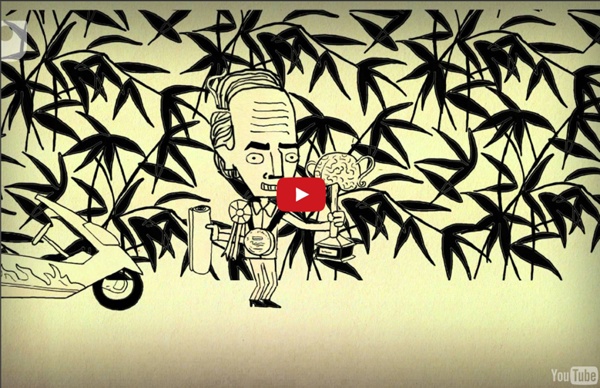



http://www.youtube.com/watch?v=5zVaFjSxAZs
A little hand, big idea :-) by James You will need some fine settings on your printer to print the 60% scale hand. The model pictured is 100% and prints easily with .25mm layers. But for 60% I used 0.18 layer and 0.3mm extrusion width with 12-18mm/s feed rates. Slow Motion Dancing for Japan This completely mesmerizing dance video was created by the music/dance group World Order which is led by former martial artist Genki Sudo. Intended as a message of hope, you can find Genki Sudo’s message to the Japanese and the world in these trying times below the video. “The unprecedented disasters unfolding in Japan; earthquakes, tsunami, and nuclear explosions, will somehow change things to come.
Content Curation: How to do it Right? - Lander Blog Content marketing. If you are even remotely involved in the marketing world, chances are you have heard about it. A lot! High-voltage engineers create nearly 200-foot-long electrical arcs using less energy than before (Update) Photos taken by the researchers show plasma arcs up to 60 meters long casting an eerie blue glow over buildings and trees at the High Voltage Laboratory at the University of Canterbury in New Zealand. A team of engineers at Canterbury University in New Zealand has developed a method to create nearly 200-foot-long electrical arcs -- visible currents of electricity traveling through air that has been broken down into electrically charged particles. Others have created longer arcs, but the traditional technique requires large amounts of energy in order to break down the air.
Guy travels the world and shoots 1 second of footage in each location (Video) 3 guys, 44 days, 11 countries, 18 flights, 38 thousand miles, an exploding volcano, 2 cameras and almost a terabyte of footage… all to turn 3 ambitious linear concepts based on movement, learning and food ….into 3 beautiful and hopefully compelling short films. - Rick Mereki : Director, producer, additional camera and editing - Tim White : DOP, producer, primary editing, sound - Andrew Lees : Actor, mover, groover - Music Recorded and mixed by Jake Phillips - Assistance in titles and production design : Lee Gingold, Jason Milden, Rohan Newman
i’m jealous of fabienne rivory i’m jealous of fabienne rivory Ooooh! Mirrored black and white photographs, with what is clearly the perfect amount of brightly-hued watercolor paint. Decision support system A Decision Support System (DSS) is a computer-based information system that supports business or organizational decision-making activities. DSSs serve the management, operations, and planning levels of an organization (usually mid and higher management) and help to make decisions, which may be rapidly changing and not easily specified in advance (Unstructured and Semi-Structured decision problems). Decision support systems can be either fully computerized, human or a combination of both. While academics have perceived DSS as a tool to support decision making process, DSS users see DSS as a tool to facilitate organizational processes.[1] Some authors have extended the definition of DSS to include any system that might support decision making.[2] Sprague (1980) defines DSS by its characteristics: DSSs include knowledge-based systems. Typical information that a decision support application might gather and present includes:
Expert system An expert system is divided into two sub-systems: the inference engine and the knowledge base. The knowledge base represents facts and rules. The inference engine applies the rules to the known facts to deduce new facts. Inference engines can also include explanation and debugging capabilities.[10] History[edit] Edward Feigenbaum in a 1977 paper said that the key insight of early expert systems was that "intelligent systems derive their power from the knowledge they possess rather than from the specific formalisms and inference schemes they use" (as paraphrased by Hayes-Roth, et al.)
How Khan Academy is using Machine Learning to Assess Student Mastery See discussion on Hacker News and Reddit. The Khan Academy is well known for its extensive library of over 2600 video lessons. It should also be known for its rapidly-growing set of now 225 exercises — outnumbering stitches on a baseball — with close to 2 million problems done each day. To determine when a student has finished a certain exercise, we award proficiency to a user who has answered at least 10 problems in a row correctly — known as a streak. Proficiency manifests itself as a gold star, a green patch on teachers’ dashboards, a requirement for some badges (eg. gain 3 proficiencies), and a bounty of “energy” points. Basically, it means we think you’ve mastered the concept and can move on in your quest to know everything.
Artificial intelligence community mourns John McCarthy 25 October 2011Last updated at 18:45 Artificial intelligence researcher, John McCarthy, has died. He was 84. The American scientist invented the computer language LISP. It went on to become the programming language of choice for the AI community, and is still used today. Professor McCarthy is also credited with coining the term "Artificial Intelligence" in 1955 when he detailed plans for the first Dartmouth conference. London Hackspace The Workshop Lab24 The Quiet Room, with workshop in progress Lab24 (from the other side) The London Hackspace is a non-profit hackerspace in central London: a community-run workshop where people come to share tools and knowledge. We're a thriving community of hackers, electronics geeks, makers, tinkerers, metal and woodworkers, lockpickers, knitters, beer brewers, and much more.